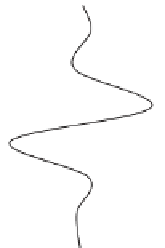Geology Reference
In-Depth Information
Phase angle
Time
0
180
0
90
Phase angle
Frequency
180
-180
270
(-90)
Figure 3.2
Illustration of phase; showing several waveforms with the same frequency but different phase (i.e different timing of the
waveforms relative to the zero reference point). The turning wheel model describes the angular relations intrinsic to the advancement of
the waveform.
Decomposed into single
frequency components
Wavelet
Plot of phase against frequency
Phase
180
Time zero
0
-180
Frequency
Time
Time
Figure 3.3
Constant phase wavelet (+90°) (J. Chamberlain, personal communication).
3.4 Change of wavelet shape
with depth
The Earth filter can have significant effects on the amp-
litude and phase spectrum of the wavelet.
Figure 3.8
shows an example where the seabed response corres-
ponds to a
initially zero phase wavelet (
Fig. 3.7
). As the phase
rotates, the relative amplitudes of the peak and
trough loops of the wavelet change. At a phase angle
of 90° the two loops have the same amplitude. Note
that the description of phase is dependent on the
reference polarity. It is most common to reference
polarity descriptions to positive standard polarity
(
Chapter 2
).
60° phase rotated zero phase wavelet,
whereas at the target the optimum wavelet for the well
25
























































